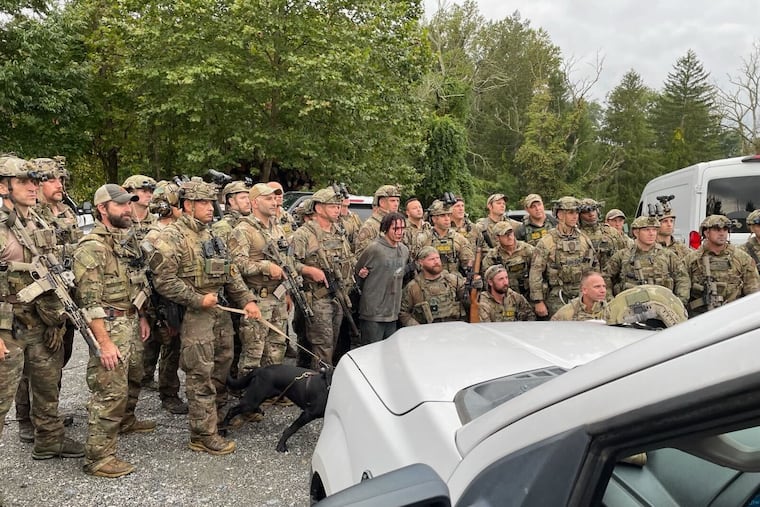Group ‘photo shoot’ of law enforcement posing with Danelo Cavalcante draws backlash
On Wednesday, Pennsylvania State Police Lt. Col. George Bivens said he wasn't bothered by the photo. Some experts say he should be.

After a two-week search through the thick brush of Chester County that drew national media attention, law enforcement finally captured escaped murderer Danelo Cavalcante on Wednesday morning — and almost immediately drew backlash.
His escape had put the county on edge, prompting business and school closures. Cavalcante had been convicted of first-degree murder for stabbing his ex-girlfriend dozens of times in front of her two young children in 2021.
» READ MORE: Danelo Cavalcante survived on watermelon and creek water and stole clothing during his two-week run from police
News of his capture brought a collective sigh of relief. Then came the aerial footage of more than 20 Pennsylvania State Police troopers and U.S. Border Patrol agents posing with Cavalcante in the middle before they took him away for questioning.
Almost immediately, people bristled at the viral photo-op. One journalist and community organizer called it reminiscent of the notorious photos to come out of Abu Ghraib where soldiers posed with Iraqi detainees being tortured or placed in humiliating positions.
Maria “Maki” Haberfeld, a professor of police science and department chair at John Jay College in New York City, said it was understandable that the officers might have felt a sense of pride having arrested a very dangerous suspect.
“I will still say that the optics create more of an inappropriate feeling than it actually is,” she said.
Laurie Levenson, professor at Loyola Law School of Loyola Marymount University in Los Angeles, went further, saying the image looked like a trophy photo hunters take after they’ve captured their prey.
Like others, Levenson said law enforcement had every reason to be proud, but a group photo among themselves — without Cavalcante — would have been a better alternative. Instead, the posing of Cavalcante, so close to weapons and a dog, risks giving him notoriety.
Levenson said the photo is much different from the already “troubling practice” that is the perp walk; it was a “photo shoot of their capture.”
A century-old practice
Parading criminals, convicted and alleged, can be traced back to the 1920s, when Edgar Hoover led the FBI, according to a 2011 Reuters report on the practice. Hoover would tip off journalists to the walks so they could obtain photos. In 1949, Camden police got their own group photo with Howard Unruh, one of the worst mass murderers of his time, responsible for the shooting deaths of 13 people, including three children. And in the 1980s, then-U.S. Attorney Rudy Giuliani made the walk an “art form,” according to Levenson.
Levenson said the perp walk was meant to serve as a deterrent to criminals, letting them know they could not evade justice, while also offering a form of kudos to law enforcement.
In Cavalcante’s case, authorities did a more traditional perp walk after they’d cleaned him up and given him a hospital gown to wear.
Experts like Levenson say these images sear their way into the public memory and in cases where someone awaits trial, a staged photo could inadvertently prejudice future jury pools. Cavalcante is already set to serve a life sentence, though he faces new charges for his escape.
Giving criminals celebrityhood
Most people were actively rooting for Cavalcante’s capture.
Still, the way he escaped — climbing the space between two walls like some sort of human spider — then managed to breach police perimeters and steal a van, turned him into a meme, with some finding the humor in how he could evade authorities.
Cavalcante even became a sort of cult hero in Brazil, according to the Washington Post.
By posing him in a photo with authorities, Levenson said, police risked giving him the sort of attention that can be damaging to victims and their families, and increases the risk of copycats.
“It wouldn’t surprise me if the victims or others sympathetic to them are saying, ‘Why are you giving this guy the limelight?’” she said.
What are authorities saying?
A U.S. Marshals spokesperson told The Inquirer none of its agents were in the photo. A Bureau of Alcohol, Tobacco, Firearms and Explosives special agent in charge told the Associated Press none of its officers were in the picture either.
When asked about the photos Wednesday, State Police Lt. Col. George Bivens didn’t make much of them.
“Those men and women worked amazingly hard, through some very trying circumstances,” he said. “They’re proud of their work. I’m not bothered at all by the fact they took a photograph with him in custody.”
A state police spokesperson could not immediately say whether the photo met the agency’s conduct policy and U.S. Customs and Border Protection did not respond to a request for comment.
People like Levenson said the photo shoot boils down to professionalism and avoiding the risk of portraying someone in a sympathetic light.
“At the end of it, the prize is not a picture with what you captured, but just the satisfaction of knowing you’ve done your job,” she said.